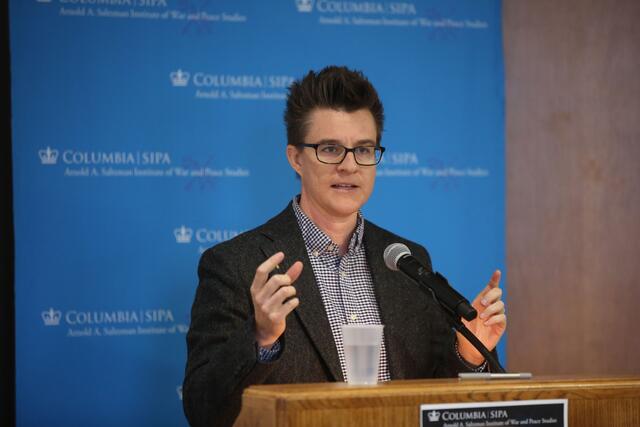
On Political Defiance and Regime Changes

The current news of civil and nonviolent protests occurring all over the world might leave one believing the 21st century has prompted some of the most engaged and vocal opponents of oppression. Unfortunately, the increased media coverage fails to show the grinding work that organizing often entails—and how difficult it is for a movement to truly achieve its goals.
In a visit to SIPA on October 9, Harvard Professor Erica Chenoweth discussed the remarkable changes that civil resistance movements have led to over the past century—movements that she said have started to decline from its height in the 1980s. Her lecture, “The Paradox of Civil Resistance in the 21st Century,” was the 11th Annual Kenneth N. Waltz Lecture in International Relations, hosted by the Saltzman Institute of War and Peace Studies.
Labeled at various times as nonviolent resistance, unarmed struggle, or nonviolent action, this type of political action has seen a dramatic decline in effectiveness since the turn of the 21st century. In her lecture, Chenoweth discussed how something so ubiquitous, something that now seems to be the dominant form of political action, has devolved into a social media-seeking publicity stunt that regimes are learning to ignore.
So how can you tell if a nonviolent resistance movement was successful in achieving its demands?
“We try to show that the campaign had had a direct impact on that outcome, so that [the outcome] wouldn't have happened if the campaign had not existed,” said Chenoweth, explaining the primary criteria.
She also addressed how nonviolent resistance is often misconstrued as passive resistance or having pacifist approaches.
“When I talk about armed resistance or violent resistance, I'm talking about a form of action where people are generally armed and are using physical violence against their opponents,” Chenoweth said. “The reason why I'm focusing on the maximalist claims, is precisely because so many people are skeptical about the utility of unarmed people power action in these types of conflicts.
“If you've been wondering whether the past 20 years have been surprisingly tumultuous around the world, with people in the streets all the time, calling for the fall of dictatorships or whatever, that is definitely what the data are showing us,” Chenoweth said. “But one thing that I think is really important and unique is the simultaneous decline in the use of armed action at the same time.
“It's not just that people are shouting more or opposing more, it's that they're doing so using nonviolent methods to a degree that we actually haven't seen in the past 120 years.”
However, Chenoweth notes a paradox between the 2010s being considered, arguably, “the most contentious decade” over the same 120 years and data proving that in the same decade, nonviolent resistance “has declined its success rates precipitously.”
Chenoweth said that regimes are using new tactics to thwart nonviolent movements, like blaming foreigners and outsiders; censoring, spinning, and using surveillance; keeping out independent journalists; and sharing information on how to suppress dissent with allies.
Unfortunately, the tactics seem to be working.
Chenoweth said the first indicator of whether a movement will be successful is if it has a large number of participants. Three percent of the national population “seems to be a pretty critical threshold of participation,” she said.
Working with fellow researcher Margherita Belgioioso, Chenoweth found a simplified equation for coming up with a campaign’s success rate: mass (the number of people in a country protesting on any given day) times the number of protests that have happened in the previous week.
The equation, she said, is “one of the most powerful predictors of whether a regime will collapse that day. So it’s actually an incredibly predictive kind of metric for how close the campaign is to succeeding.”
One of the tactics regimes employ to hold power include having a tight hold on military control. Chenowith brought up the example of Yugoslavian president Slobodan Milosevic as what happens when a regime loses its martial power. After troops had surrounded protesters, Milosevic ordered the army shoot live ammunition into the crowd. The troops did not move.
“In this context, the critical pillar upon whom there was an attempt to rely on, defected,” Chenoweth explained. “And they didn't defect by throwing down their guns and joining the protesters, they just defected by feigning ignorance about an order that they didn't think was wise for them to follow.”
This is one of the main reasons why nonviolent resistance tends to be riskier for regimes to control than violent ones, she said. First, a regime attacking unarmed resisters comes off as “outrageous morally and disproportionately excessive and brutal.” It’s also impractical for oppressive regimes to keep up with added security and evidently, the extra costs of hiring more staff to secure key areas.
Chenoweth concluded her lecture by laying out the four fundamentals of a successful nonviolent campaign: “They were large, diverse, and had a lot of momentum. They maintain discipline. They elicited loyalty shifts within the pillars of support, and they shifted their methods so they weren't overly relying, for example, on protest.”
— Catherina Gioino MPA ’20